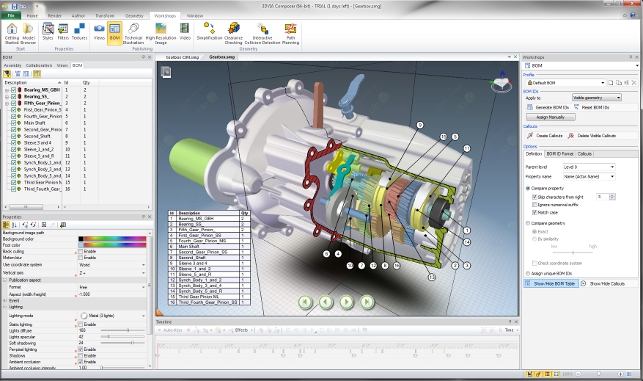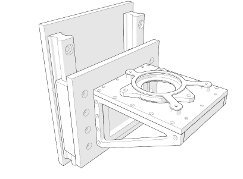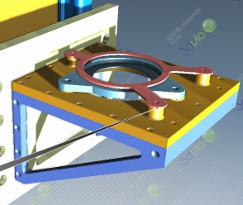Product documentation is used by many stakeholders in many formats from traditional print through online catalogues to fully interactive training and service manuals.

Integrated Bill of Materials (BOM) tools for true technical publishing
Never the forte of CAD applications themselves, technical publishing tools need to provide better integration than the traditional workflow of manually pasting and updating bitmap images into Word or Publisher documents.
Fortunately the dedicated authoring tools just keep getting better, providing CAD data associativity to maintain up to date content, and enhancing effectiveness and control over graphical richness to suit the publication.
Clear graphical instructions that avoid multiple text translations are increasingly necessary and can significantly reduce misunderstandings or misinterpretation. At its simplest, 3DVIA Composer provides a bridge between CAD data and technical publication.
Based on XML and using a paper space structure, a sequence of images can be generated and managed complete with annotations and interactive controls to communicate key product messages.
These can be published directly to PDF, HTML or 3DVia.com or saved out as assets for insertion as vector line art or high resolution images into a document creation tool such as Word. Any CAD data changes can be readily updated in 3DVIA Composer, annotations tweaked, images exported and publishing tool updated in as few as four steps.
With product development timelines under increasing pressure the ability to commence documentation in parallel with design iteration allows for better proofing and documentation. One-way associativity means that a broader range of disciplines can have access to the product design data from an early stage, but with no danger of non-technical staff inadvertently altering this data.
The Composer interface comprises a central graphics area that toggles between the standard page view mode and the animation interface complete with timeline appearing along the bottom.
A pane down the left contains Assembly, Collaboration and Views. Below that, a pane displays properties of any selected elements.
Groupings of functionality are described as workshops and, when selected, relevant settings appear in a further pane down the right hand side.
In addition to SolidWorks and CATIA, 3DVIA Composer can import native Pro/Engineer data, and other design data sets through the STEP and IGES exchange formats.
Somewhat theatrically, objects in the viewport are called ‘actors’. So, parts, assemblies, and components of the 3D model are ‘geometry actors’ while annotations, measurements, and other mark-ups are ‘collaborative actors’.
Model and view manipulation will be intuitive to CAD users and comprehensive help topics together with standard Windows and Office shortcuts will aid non-technical users be rapidly productive.
For convenient multi-use, once selected, commands remain active until cancelled with Esc. Component visibility control is crucial to effective work and can be managed in many ways ranging from selection in the assembly tree, including highlighting even if hidden, to handy temporary hiding of selected geometry to show underlying components using the tab key.
The Digger tool, readily accessible on the spacebar, provides powerful ways to create detail views. A movable, resizable ring can be placed over or adjacent to the model with associated controls to locate the centre of interest.
Then zoom into the contents, apply a cutting plane and progressively peel away geometry with or without a ghosted image. The result can be captured as an image or by key framing parameters, viewed as fully animated Digger effects. This is a great tool!
Ribbon toolbars provide access to extensive functionality. The render tab includes render mode selection, depth of field to blur distant objects and lighting setup.
Author provides mark-up tools, panels for inclusion of images such as navigation buttons, label and call-out annotations, dimensions and cutting planes. Grids can be applied to aid placement of geometry while magnetic lines align and uniformly space annotations, measurements and 2D panels.
As opposed to manual creation of instructional arrows onto pre-created 2D images, placement intelligently snaps to axes and geometry, rapidly creating precise and intelligent mark-ups that can be readily customised to suit specific applications or conforming to a predefined style.
The path command creates lines to indicate geometry displacements in views or animations, and can be associative to update automatically if the geometry moves. Transform provides a wide range of tools for aligning, moving, exploding and constraining geometry.
Geometry actors can be dragged freely or more precisely using the axis triad to restrain translation or rotation to a specific axis. Kinematics enable relative part movement and animation constrained by applied links.
The geometry tab includes tools to create primitives and manipulate existing geometry by duplicating, mirroring, replacing or scaling. Clone detection reduces file size by identifying similar geometry and creating referenced copies rather than duplicated data.
Acknowledging potential intellectual property jeopardy through publishing, the Secure 3D Brush degrades geometric fidelity to prevent reverse engineering. Measurements applied subsequently will not be accurate and the command cannot be undone.
Although this prevents transmission of geometric detail it clearly does not protect design intent IP. The final tab provides access to the range of task specific environments or Workshops.
The Styles Pane provides visibility of the sheer range of settings and the ability to rapidly apply or update them as required.
With so many options and settings available it is helpful to be able to save combinations of frequently used settings for reuse in multiple documents or to share the profiles with other users. This will ensure that stylistic updates are applied to all actors in order to achieve visual consistency.
The textures workshop provides a gallery of bitmap textures and tools for positioning and rotating to suit. Creation of Bill of Materials (BOM) tables and associated callouts is very quick, with full content and appearance customisation options.
BOM IDs can include a prefix or suffix and callouts can be displayed per instance, per ID, or with leaders to multiple instances from one balloon. Once created, hovering over table rows highlights the corresponding geometry actors and callouts to improve accessibility and understanding.
The Technical Illustration workshop generates high quality, re-scalable vector images. These are previewed in the default web browser as long as the Adobe SVG viewer plugin is installed. By controlling hidden line removal and outline options, dynamic images can be readily generated.
The user has the option to output multiple images from views or selected animation frames. Similarly videos can be output to AVI in user defi ned size and quality.
The final family of workshops are geometry tools. The simplification workshop provides several methods for simplifying the model to enhance performance.
Decimation reduces the number of triangles in the model. Although it inevitably degrades model geometry, small amounts of decimation can typically be applied without detracting noticeably from visual quality.
Occlusion removes parts from the model based on small, insignificant size or whether they are internal and therefore not visible. The clone detection tool also reappears here.
3DVIA Composer provides a comprehensive set of product documentation publishing or asset creation tools that are easy to use without compromising design control, flexibility or quality of output
A clearance checking workshop provides static clash detection, clearance checking and minimal distance analysis for the entire model, selected parts or visible parts. The interactive collision detection tab gives feedback and can halt or zoom in on clashes during animated sequences.
Most intriguingly, the path planning workshop computes collision-free paths between defined geometry locations enabling instructional animations to be created to show how those awkward, tight fitting parts need to be manipulated for assembly or removal.
Complex animations can be generated using explode tools or manually creating key frames for component locations, camera views, sections or opacity to control visibility. Creation of multiple cameras enables rapid switching between views in animations.
Additionally, comprehensive camera controls, including roll, pitch and yaw, provide full creative freedom. For electronic delivery a standalone player is available including a Pro version with full API customisation capabilities in addition to browser plug-in readers.
3DVIA Composer provides a comprehensive set of product documentation publishing or asset creation tools that are easy to use without compromising design control, flexibility or quality of output whether for electronic or print media.
Product communication is all about clarity and there are few limitations on information presentation allowing users to get the often complex messages across effectively.
Although priced comparably to a CAD seat, dedicated and optimised tools rarely turn out to be a wasted investment for professional, effective delivery so for workflows requiring high quality, up-to-date 3D product documentation, 3DVIA Composer could well be the tool of choice.
| Product | 3DVIA Composer V6R2012 |
|---|---|
| Company name | Dassault Systèmes |
| Price | on application |








